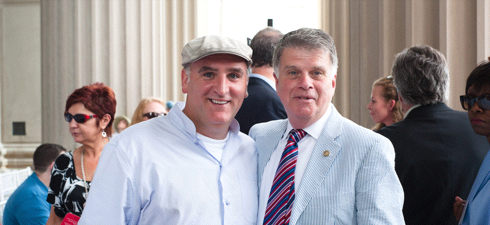Super Chef attended a recent lecture at the National Archives called America Eats Series: Food Frights! Food Safety Then and Now, featuring Chef Jose Andres.
Jose is no stranger to the National Archives. He has a pop up restaurant called America Eats Tavern across the street from the building, and contributed an introduction to Eating with Uncle Sam: Recipes and Historical Bites from the National Archives (D. Giles 2011):
What we eat today isn’t just about immigration or the land or technology, it is also about the hand of Government, both directly and indirectly influencing what we eat. The necessities of wartime brought publications like Without Wheat, Sweets without Sugar, and Potato Possibilities. (p. vii)
Even among conservatives who want less government, there is an expectation that the government will ensure a safe food suply. He also points out that there was a market at the site of the National Archives from 1870 to 1930 where Washingtonians could come for fresh food.
The Monster Mash played before the panel was assembled to put a Halloween spin on the talk – but this was about serious food frights – arsenic in flour, sand used to fill out sugar, borax and other chemicals in meat – enough chemicals and poisons to kill people. Moderated by NBC’s David Gregory, the panel featured USDA’s Philip Derfler who heads up the Food Safety and Inspection Service, a self-styled curmudgeon. Caroline Smith DeWaal, director the food safety program of the Center for Science in the Public Interest, and Dr. Suzanne Junod, a Senior Historian at the FDA.
Historically, the beginning of food safety regulation dates back to the 1906 Pure Food and Drug Act that provided for provided federal inspection of meat products and outlawed the manufacture and sale of adulterated food products and poisonous medicines. It was the result of Upton Sinclair‘s The Jungle as well as a government report on the meat industry.
Jose Andres said that the focus should not be on what temperature pork is prepared at his restaurants but on the importance of not letting one company or a handful of companies dominate American or World food production. He stressed that of the 330 billion meals served every year in America, relatively few people get sick (1 in 6 Americans). He also spoke about his work importing Iberico ham from Spain to the US. He found out that the European Union and the US do not share food safety regulations. He had to get a food safety inspector from the US – who turned out to be a Pakistan who did not eat pork!
The speakers concluded that more could to be done to ensure food safety and food security, focusing on prevention rather then inspection. Funding needs to be increased in order to find food safety issues more quickly.
If you missed the lecture, pick up Eating with Uncle Sam for recipes like President Kennedy’s New England Fish Chowder (p. 38), Nancy Reagan’s Veal Stew with Red Wine (p. 71) or Bess Truman’s Bing Cherry Mould (p. 118). There are marvelous historic photographs of the presidents, labels from food products, and food workers.

